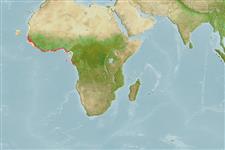>
Carangaria/misc (Various families in series Carangaria) >
Polynemidae (Threadfins)
Etymology: Polydactylus: Greek, poly = a lot of + greek, daktylos = finger (Ref. 45335).
More on author: Cuvier.
Environment: milieu / climate zone / depth range / distribution range
Ecologia
marino; acqua dolce; salmastro demersale; distribuzione batimetrica 15 - 55 m (Ref. 10799). Tropical; 22°N - 5°S, 26°W - 13°E (Ref. 57343)
Eastern Atlantic: Senegal to Angola (Ref. 57402). Also reported from Mauritania (Ref. 55783).
Size / Peso / Age
Maturity: Lm ? range ? - ? cm
Max length : 200 cm TL maschio/sesso non determinato; (Ref. 57402); common length : 150 cm TL maschio/sesso non determinato; (Ref. 3659); peso massimo pubblicato: 75.0 kg (Ref. 7386)
Spine dorsali (totale) : 9; Raggi dorsali molli (totale) : 12 - 13; Spine anali: 3; Raggi anali molli: 11 - 12. Diagnosis: pectoral fin with 4 threadlike filaments (Ref. 57402, 81658). Pectoral fin inserted very low on body, generally somewhat longer than upper part of fin (Ref. 57402).
Occurs in shallow coastal waters, over sandy and muddy bottoms, sometimes in brackish habitats (Ref. 57343, 81658). Enters estuaries (Ref. 57402), occasionally caught in fresh water (Ref. 57402, 81658). Very large specimens are only found in marine waters (Ref. 81658). Feeds on crustaceans and fishes (Ref. 10799, 81658). Flesh fairly tasteful (Ref. 57402).
Life cycle and mating behavior
Maturità | Riproduzione | Deposizione | Uova | Fecundity | Larve
Motomura, H., 2004. Threadfins of the world (Family Polynemidae). An annotated and illustrated catalogue of polynemid species known to date. FAO Spec. Cat. Fish. Purp. Rome: FAO. 3:117 p. (Ref. 57343)
IUCN Red List Status (Ref. 130435: Version 2024-2)
Threat to humans
Harmless
Human uses
Pesca: commerciale; Pesce da pesca sportiva: si
Strumenti
Special reports
Download XML
Fonti Internet
Estimates based on models
Preferred temperature (Ref.
123201): 22.3 - 28, mean 26 °C (based on 48 cells).
Phylogenetic diversity index (Ref.
82804): PD
50 = 0.5000 [Uniqueness, from 0.5 = low to 2.0 = high].
Bayesian length-weight: a=0.00676 (0.00529 - 0.00865), b=3.10 (3.04 - 3.16), in cm total length, based on LWR estimates for this species (Ref.
93245).
Trophic level (Ref.
69278): 4.0 ±0.66 se; based on food items.
Generation time: 2.7 ( na - na) years. Estimated as median ln(3)/K based on 2
growth studies.
Resilienza (Ref.
120179): Medio, tempo minimo di raddoppiamento della popolazione 1.4 - 4.4 anni (K=0.34-0.41; assuming tm=3-4).
Prior r = 0.57, 95% CL = 0.37 - 0.85, Based on 3 data-limited stock assessments.
Fishing Vulnerability (Ref.
59153): Moderate vulnerability (44 of 100).
Climate Vulnerability (Ref.
125649): Very high vulnerability (87 of 100).
Nutrients (Ref.
124155): Calcium = 59.4 [32.4, 109.8] mg/100g; Iron = 0.818 [0.418, 1.451] mg/100g; Protein = 20.1 [18.5, 21.7] %; Omega3 = 0.213 [0.132, 0.349] g/100g; Selenium = 79.1 [38.5, 162.9] μg/100g; VitaminA = 6.04 [2.46, 14.30] μg/100g; Zinc = 0.742 [0.514, 1.115] mg/100g (wet weight);
